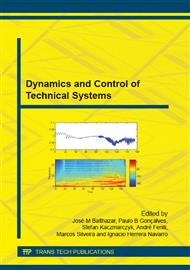[1]
M. O. Tokhi and A. K. M. Azad, Flexible Robot Manipulators: Modelling, Simulation And Control, Published by The Institution of Engineering and Technology, London, UK, (2008).
Google Scholar
[2]
J. M. Renno, Inverse Dynamics Based Tuning of a Fuzzy Logic Controller for a Single-Link Flexible Manipulator, Journal of Vibration and Control 2007, 13, 1741, DOI: 10. 1177/1077546307076282.
DOI: 10.1177/1077546307076282
Google Scholar
[3]
R. R. Waiboer, Dynamic modelling, identification and simula-tion of industrial robots for off-line programming of robotised laser welding. PhD thesis, University of Twente, Enschede, The Netherlands, (2005).
DOI: 10.3990/1.9789077172254
Google Scholar
[4]
B. Bona and and M. Indri, Friction compensation in robotics: an overview. In: Proceedings of the 44th IEEE Conference on Decision and Control, and the European Control Conference. Seville, Spain, (2005).
DOI: 10.1109/cdc.2005.1582848
Google Scholar
[5]
E. Panteley, R. Ortega and M. Gafvert, An adaptive friction compensator for global tracking in robotic manipulator. Systems and Control Letters 33, 307–313, (1998).
DOI: 10.1016/s0167-6911(97)00113-8
Google Scholar
[6]
E.J. Haug, S.C. Wu, and S.M. Yang, Dynamics of Mechanical Systems with Coulomb Friction, Stiction, Impact, and Constraint Addition-Deletion. I-Theory, II-Planar Systems, and III-Spatial Systems, Mechanism and Machine Theory, Vol. 21, pp.401-425, (1986).
DOI: 10.1016/0094-114x(86)90090-x
Google Scholar
[7]
J. S. Shamma and J. R. Cloutier, Existence of SDRE Stabilizing Feedback, IEEE Transactions on Automatic Control, 48, 513-517, (2003).
DOI: 10.1109/tac.2002.808473
Google Scholar
[8]
J. R. Cloutier, D. T. Stansbery and M. Sznaier, On the recoverability of nonlinear state feedback laws by extended linearization control techniques, Proceedings of the American Control Conference, San Diego, California, June 1999, pp.1515-1519.
DOI: 10.1109/acc.1999.786078
Google Scholar
[9]
A. Fenili and J. M. Balthazar, Control of a Rigid-Flexible Two Link Nonlinear Robotic Manipulator Using the SDRE Method, 10th Conference on Dynamical Systems Theory and Applications, 2009 - Łódź, Poland.
Google Scholar
[10]
T. Çimen, State-Dependent Riccati Equation (SDRE): A Survey, Proceedings of the 17th World Congress, The International Federation of Automatic Control, Seoul, Korea, July 6-11, pp.3761-3775, (2008).
DOI: 10.3182/20080706-5-kr-1001.00635
Google Scholar
[11]
A. Fenili and J. M. Balthazar, The rigid-flexible nonlinear robotic manipulator: modeling and control, Communications in Nonlinear Science and Numerical Simulations, Vol. 16, Issue 5, 2011, p.2332–2341.
DOI: 10.1016/j.cnsns.2010.04.057
Google Scholar
[12]
A. Fenili, Position and Vibration Control of a Nonlinear Slewing Flexible Structure Using the SDRE Method, 8th Brazilian Conference on Dynamics, Control and Applications – DINCON 2009, 2009 - Bauru, SP / Brasil.
Google Scholar
[13]
E. P. Popov, Introdução à Mecânica dos Sólidos, Editora Edgar Blücher Ltda, (1978).
Google Scholar
[14]
E. Barbieri and Ü. Özgüner, Unconstrained and constrained mode expansions for a flexible slewing link, Transactions of the ASME, Vol. 110, December 1988, pp.416-421.
DOI: 10.1115/1.3152705
Google Scholar
[15]
R. M. Rosenberg, Analytical Dynamics of Discrete Systems, Plenum Press, NY, (1977).
Google Scholar
[16]
R. W. Cloug and J. Penzien, Dynamics of structures, McGraw-Hill, Tokio, Japan, (1975).
Google Scholar
[17]
N. D. Vuong and M. H. Ang Jr. Dynamic Model Identification for Industrial Robots, Acta Polytechnica Hungarica, Vol. 6, No. 5, (2009).
Google Scholar


